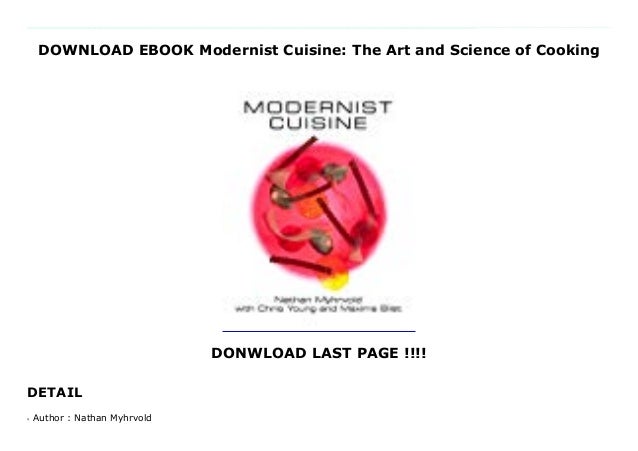With changes in how we cook and eat the fields of culinary arts and culinary science appear now to be merging into one. Many famous restaurant now have cooking laboratories on their premises, while universities and colleges around the country are beginning to offer degrees in culinology ( a degree program that blends food science and technology with culinary art).
Interest in food science has grown in recent years because of the increasing awareness of the vital role of food in the health, well-being, and economic status of individuals and nations and people's curiosity and desire to try new and innovative food dishes. Food science is the study of the chemical composition of food and food ingredients; their physical, biological and biochemical properties and and the interaction of food constituents with each other and their environment.
What is Molecular Gastonomy?
Cook, Taste, Learn How the Evolution of Science Transformed the Art of Cooking 31 The Art of Cooking and the Science of Atoms. Atomic Theory (1805). John Dalton –meteorologist. Greatest advance in science. Understand food and cooking at the molecular level. “The essence of science: ask an impertinent question and you are on. Modernist Cuisine: The Art and Science of Cooking: Nathan Myhrvold, Chris Young, Maxime Bilet: 007: Books - Amazon.ca. Nathan Myhrvold, founder of The Cooking Lab, has had a passion for science, cooking, and photography since he was a boy. By the age of 13, Nathan had already cooked the family Thanksgiving feast and transformed the household bathroom into a darkroom. Art and Science of Indian Cooking. Learn how to cook healthy and authentic Indian cooking and understand about spices.
Molecular Gastronomy is the application of scientific principles to the understanding and improvement of small scale food preparation. The term was invented by the Hungarian physicist Nicholas Kurti in a 1969 presentation to the Royal Institution called 'The Physicist in the kitchen', and popularized by his collaborator the French scientist Hervé This.
Heston Blumenthal, 38, is presently at the forefront of this radical style of cooking (molecular gastronomy). His triple Michelin starred restaurant The Fat Duck serves dishes like sardine-flavored sorbet, pasta made out of Jello, snail porridge, or a puree of mango and Douglas fir. At El Bulli, the restaurant of Ferran Adria in Spain another molecular gastronomist dishes consist of monkfish liver with tomato seeds and citrus or barnacles with tea foam, or a parmesan cheese ice cream. During the six months his restaurant is closed, Adrià works on new recipes in a laboratory near the Barcelona market.
At restaurant Arzak in San Sebastian, Juan Mari Arzak and his daughter Elena experiment with their chefs on a daily basis. Upstairs from the restaurant you will find a small food laboratory with pH meters, sonicators and liquid nitrogen.
EGG AND TRUFFLE FLOWER IN GOOSE FAT WITH CHISTORRA (chorizo sausage) OF DATES From Restaurante Arzak Restaurant Everyday we experiment and investigate with the flavours, textures and elaboration's processes. Besides the investigation's kitchen there is a 'Flavour Bank', that contains more than 1000 products and ingredients we use to their investigations and for the new creations -- -- Juan Mari Arzak |
Pino Maffeo of Boston's Restaurant L uses liquid nitrogen, emulsifiers and an arsenal of equipment typically found in scientific laboratories, Maffeo creates what he calls 'one-bite wonders.' 'If science can make my cuisine better, then I'll use it,' he said, while putting ravioli made from mango and dry cured ham on skewers alongside aloe vera and muscato grape juice gelatin cubes.
To create unusual and original recipes -- such as pairing fried calamari with watermelon and cantaloupe -- Maffeo analyzes the molecular make-up of the ingredients with an infrared spectrometer nuclear magnetic resonance machine, equipment usually used by synthetic chemists and physicists. He believes foods with similar composition pair well together. He meets weekly to discuss projects with Angela Buffone, a visiting professor of organic chemistry at Suffolk University and partner in Maffeo's culinary experiments. For his signature dish, seared foie gras with a 24 carat golden egg, MDDWO uses liquid nitrogen to flash freeze an airy meringue that has been dipped in lightly whipped cream to create a texture resembling an egg shell. Then using a syringe he injects mango sauce into shell. See full text article by Mark Wilson


Experimental Chefs and restaurants
- The Fat Duck (Heston Blumenthal) - UK
- Pierre Gagnaire (Pierre Gagnaire) - France
- El Bulli (Ferran Adria) - Spain
- Grand Hotel Villa Serbellione (Ettore Bocchia) - Italy
- Saint Pierre (Emmanuel Stroobant) - Singapore
- Juan Mari Arzak, San Sebastian - Spain
- Chef Thomas Keller, whose French Laundry (California)
Further Reading

New York Times Articles -- A Laboratory of Taste
Science of Cooking --Explore recipes, activities, and Webcasts that will enhance your understanding of the science behind food and cooking.
Food: his passion, his science --Hervé This, a French researcher, helps chefs around the world really sizzle
Food Nutrition and Information Center -- The Food and Nutrition Information Center (FNIC) at the National Agricultural Library (NAL) has been a leader in food and human nutrition information dissemination since 1971.
Molecular gastronomy and the science of cooking -- Large selection of books and articles from Martin Lersch Department of Chemistry P.O.Box 1033, Blindern 0315 Oslo, NORWAY
Bertand Simon, Sciences can help us with better cooking articles in french.
New degree programs produce chef-scientists -- Culinology™ is the blending of the culinary arts and the science of food -- The Associated Press
The Art And Science Of Cooking
The Research Chefs Association is the leading professional community for food research and development. Its members are the pioneers of the discipline of Culinology®
Modernist Cuisine The Art And Science Of Cooking Volume 2
|